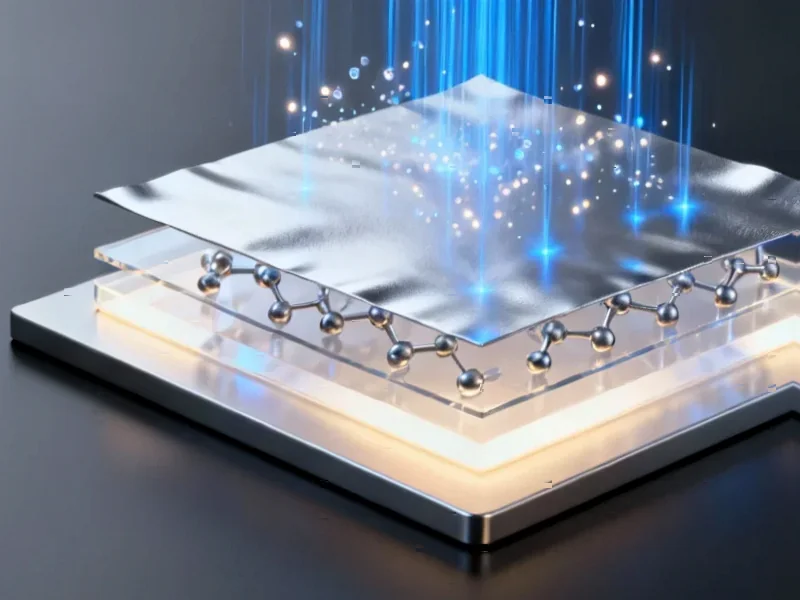According to Nature, researchers have developed an electrically driven heterostructured far-infrared wire laser with integrated graphene plasmons that achieves third harmonic generation in the terahertz range. The team engineered a surface-emitting distributed-feedback quantum cascade laser incorporating a multilayer graphene plasmonic grating and top capacitor, creating a double-grating resonator tuned to operate between 3.25-3.35 THz. Experimental results showed the device could up-convert fundamental frequencies to their third harmonic at approximately 10 THz with conversion efficiencies ranging from 1 to 5.4 × 10⁻⁸ and maximum third harmonic peak power of 9.0 μW. The graphene integration enabled electric field amplification by factors up to 10 in critical regions while maintaining laser operation, with seven fabricated devices demonstrating consistent behavior and gate-tunable performance through electrostatic control of the graphene Fermi level.
Table of Contents
Bridging the Terahertz Gap
The significance of this research lies in addressing what’s known as the “terahertz gap” – the challenging frequency range between microwave and infrared where conventional electronic and photonic technologies struggle. While quantum cascade lasers have made impressive strides in generating terahertz radiation, extending their operation to higher frequencies has remained a persistent challenge. This graphene integration approach represents a fundamentally different strategy than simply developing new semiconductor materials or structures. By leveraging graphene’s unique plasmonic properties, researchers can effectively “multiply” the frequency of existing terahertz sources rather than creating entirely new ones. This could have profound implications for spectroscopy, security screening, and medical imaging applications that require specific frequency bands within this difficult-to-access portion of the electromagnetic spectrum.
The Plasmonic Engineering Breakthrough
What makes this approach particularly clever is the strategic placement of the graphene plasmonic grating. Rather than coating the entire device, the researchers patterned the multilayer graphene ribbon array specifically toward the edges of the top contact region, leaving the central area untouched. This design choice demonstrates sophisticated understanding of plasmon behavior and loss management in integrated photonic systems. The partial coverage mitigates the increased optical losses that would normally accompany such integration while still providing the necessary field enhancement for efficient harmonic generation. The quality factor reduction from Q≈71 to Q≈29, while significant, appears to be an acceptable trade-off given the substantial field amplification achieved – a calculated enhancement factor of approximately 2.5 across the entire surface and nearly two orders of magnitude in the critical central region.
Nonlinear System Limitations
The conversion efficiency numbers, while impressive for a first demonstration, highlight the fundamental challenges of nonlinear optical processes in practical devices. Conversion efficiencies in the 10⁻⁸ range mean that enormous input powers are required to generate usable output signals at the third harmonic frequency. The researchers’ choice to work with a high-power terahertz QCL delivering 2.5 W peak power wasn’t arbitrary – it was necessary to overcome these inherent efficiency limitations. What’s particularly interesting is their observation that the conversion efficiency behavior differs from previous reports on doped graphene systems, which they attribute to the quasi-continuous wave excitation dynamics in their laser system. This suggests that the interplay between graphene’s nonlinear response and the specific excitation conditions creates unique opportunities for optimization that haven’t been fully explored in earlier work.
Practical Manufacturing Considerations
The fabrication process described reveals several significant manufacturing challenges that must be addressed before commercial deployment becomes feasible. The requirement for electron beam lithography to pattern the plasmonic grating with precise alignment to the underlying DFB grating suggests this isn’t yet a scalable manufacturing approach. The sequential transfer of three graphene layers using PMMA-assisted wet methods, while successful in the laboratory, would need substantial refinement for mass production. The researchers’ own experience supports this – they noted that devices from an improved fabrication batch with dry-etched slits and smoother sidewalls showed significantly better performance, highlighting how sensitive these integrated systems are to manufacturing variations. The inhomogeneous Fermi level across large-area graphene samples presents another fundamental challenge for consistent device performance.
Advanced Resonator Architecture
The double-grating resonator design represents a sophisticated approach to controlling electromagnetic modes within constrained spaces. By combining a second-order DFB grating for optimal mode control within the laser’s optical band with a plasmonic grating for field enhancement, the researchers have created a hybrid system that leverages the strengths of both photonic and plasmonic confinement strategies. The observation that the plasmonic grating induces two side lobes with approximately 15° angular broadening, compared to the typical single lobe profile with ≤10° divergence in standard surface-emitting DFB QCLs, provides insight into how the plasmonic elements modify the far-field emission characteristics. This beam shaping effect could actually be beneficial for certain applications requiring specific illumination patterns.
Pathways to Practical Applications
Looking forward, the most immediate applications will likely emerge in specialized scientific instrumentation where the ability to generate specific far-infrared frequencies outweighs cost and complexity considerations. The gate-tunable nature of the conversion efficiency, controlled through the graphene Fermi level, provides a valuable degree of experimental flexibility that pure semiconductor approaches lack. However, the current power levels at the third harmonic – 9.0 μW peak power translating to 450 nW average power – will need substantial improvement for most practical applications. The researchers’ identification of optimal operating conditions around E≈200 meV Fermi energy provides a clear target for future optimization efforts. As fabrication techniques improve and our understanding of graphene plasmonics in laser resonators deepens, we can expect to see continued progress in both conversion efficiency and output power from these hybrid systems.



